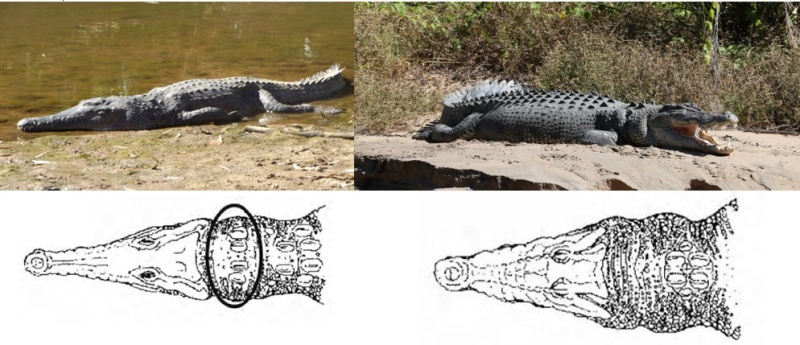
Saltwater crocodile at Lacepede Islands – Nigel Jackett
Crocodile biology and ecology
Crocodile evolution history dates back 200 million years ago to a time before dinosaurs roamed the Earth.
This ancient group of reptiles lived through the Cretaceous period and successfully survived the great ice age periods of the past two million years. Perfectly adapted to their environment, today’s crocodiles differ very little from their ancient relatives.
Two species of crocodile are found in the waters of northern Western Australia:
- Australian Johnston’s freshwater crocodile (Crocodylus johnstoni), endemic to Australia
- Estuarine (saltwater) crocodile (Crocodylus porosus), widespread in the Indo-Pacific region, from northern Australia, across Southeast Asia, to India and Palau.

Both species are found extensively throughout northern Australia, with the estuarine (saltwater) crocodile extending in the east as far as Townsville in Queensland. In Western Australia, known crocodile habitat extends south to Exmouth, with occasional records further south to Carnarvon.
Johnston’s freshwater crocodile
Inhabit freshwater rivers, creeks, artificial lakes and occasionally tidal reaches. They are not considered to be aggressive unless provoked.

Appearance
Males can grow up to 3 metres with an average size of 2 metres whilst females can grow up to 2 metres with an average size of 1.5 metres. Their relatively small size and narrow snout distinguish them from estuarine (saltwater) crocodiles, as well as the pattern of bony scales on their head and neck.
Nesting
Johnston’s freshwater crocodiles’ nest during dry season (late August- early September) with hatching occurring approximately 90 days later. They excavate a hole in sand or other soft soil and lay between 13 and 15 eggs.
Feeding
Their diet consists of small animals including insects, fish, frogs, lizards, turtles, bats and birds. Larger crocodiles tend to eat larger prey by stalking and ambushing in a similar manner to that of the estuarine (saltwater) crocodile.
Estuarine (saltwater) crocodile
Inhabit a wide variety of inland and coastal waterways and water bodies across northern Australia, both fresh and salt water, including estuaries, tidal rivers, river pools and the waters around offshore islands. Assume all water bodies in the Kimberley contain dangerous crocodiles. If in doubt do not swim, canoe or use small boats where crocodiles may live.

Appearance
They are the largest of all crocodile species and have been known to grow up to 7 metres long. An average male may be up to 3-4m long and weigh 200-300kg. Females rarely reach over 3.5m and weigh up to 150kg. They have wide, broad snouts and large chomping teeth.
Their skin colour varies depending on where they live and their size. Colours range from almost black through to grey and olive-brown.
Nesting
Estuarine (saltwater) crocodiles’ breed during the wet season (November-April). They build nests in vegetation and soil in which approximately 50 eggs are laid. Incubation takes approximately 90 days.
Feeding
Young estuarine (saltwater) crocodiles feed mainly on small crabs, prawns, insects and fish. Large estuarine (saltwater) crocodiles will eat any meat including fish, frogs, birds, goannas, wallabies, kangaroos, cattle or horses.
Estuarine (saltwater) crocodiles are ambush predators and will wait at the water's edge and then lunge or snap sideways at animals which come to feed or drink. If they can’t swallow an animal whole, they drag it under the water and twist it in a "death-roll" until it dies, or shake its head in an attempt to break off pieces of the animal to eat.
Conservation
The estuarine (saltwater) crocodile population was significantly reduced between 1945 and 1970 due to unregulated hunting for their skins. In 1970, Western Australia became the first state to legally protect estuarine (saltwater) crocodiles. About 300,000 animals were killed during this period, mostly in the Northern Territory, and about 25,000 in Western Australia, and there were concerns the species might not recover. The Johnston’s freshwater crocodile was given protection from hunting in Western Australia in 1962.
- Both saltwater and freshwater crocodiles are Specially Protected under the Biodiversity Conservation Act 2016. Poaching, killing or interfering with crocodiles, their eggs or habitat is an offence carrying penalties of up to $200,000. Incidents should be reported to your local Parks and Wildlife Service office.
- Under the Commonwealth Environment Protection and Biodiversity Conservation Act, the freshwater crocodile is listed as a marine species, and the saltwater crocodile is listed as both a marine and migratory species.
Management
The department's management aims to reduce the risk of crocodile attacks and ensure crocodiles are conserved in the wild.
- Kununurra and Broome have crocodile control zones where crocodiles are managed within the area for the purpose of public safety. The department will respond to all sightings of crocodiles that are reported in these areas.
- The decision on what to do with such an animal is made on a case-by-case basis. When appropriate, problem animals are caught and relocated to a crocodile farm. Crocodiles generally cannot be relocated to another area due to their territorial nature.
- Code of practice - Code of practice on the humane treatment of wild and farmed Australian crocodiles
How to be Crocwise in crocodile country

CROCS ARE COMMON: WA’s North West is ‘Crocodile Country’
CROCS MOVE AROUND: They can be found in any waterway.
CROCS ARE DEADLY: Crocodiles are dangerous, and attacks can be fatal.
BE CROCWISE: Don’t become complacent.

These messages have been developed by combining Be Crocwise safety messages from three sources: Parks and Wildlife (WA), Parks and Wildlife Commission (NT) and Environment and Heritage Protection (QLD). This approach ensures that messages are current, accurate and consistent across the Top End.
More information on the Northern Territory’s and Queensland's Be Crocwise campaign:
Be Crocwise | Environment, land and water | Queensland Government (www.qld.gov.au)


